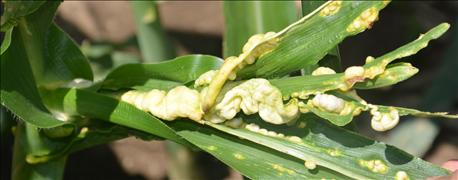
You will be walking your cornfields soon to get an idea of what kind of yield you can expect this fall. Perhaps nothing is more disappointing than reaching for what you think is another golden ear of corn and finding an ugly, grotesque ball of smut instead. It may just be a deformed ear on a plant here and there, and it likely won’t impact yield, but in a word, it’s downright "ugly."
Corn Illustrated 6/20: How much leaf disease does it take to impact yields?

WHERE SMUT STARTS: Here is a young plant soon after being infected with the fungus that causes corn smut.
What is it? Why is it there? Dave Nanda, a crops consultant in Indianapolis, provides some answers to these and other questions from Indiana Prairie Farmer. You can also check the Purdue University Corn & Soybean Field Guide for more information.
IPF: How early in the growing season can you find corn smut?
Nanda: It can begin very early in the growing season. Walking a field of corn in the V6 to V8 stage, or plants with six to eight leaves with collars exposed, we found a good example of smut already at work on a plant.
IPF: What causes this ugly disease?
Nanda: It’s caused by a fungus. The technical name is Ustilago maydis.
IPF: Where does the fungus come from?
Nanda: Spores of the fungus produced in the past survive in soil or crop residue. In areas where corn is a major crop, you can assume this fungus will be present in the field. When conditions are right, the fungus can get a foothold on an individual plant.
IPF: What conditions does it take for a plant to be infected?
Nanda: The most common cause is a wound or injury to a plant. It could be from injury during a sidedressing trip. The fungus may enter a wound created by an insect that was feeding on the plant, as well. The fungus needs an entry point to get a foothold in the plant.
IPF: When does infection occur?
Nanda: In theory it can occur anytime during the growing season. That means you could find smut developing on a very young plant or on a much older plant. If hail occurs later in the season, say near pollination time, it could cause wounds that allow the fungus to enter the plant relatively late in the season.
IPF: What are you looking for to diagnose this disease?
Nanda: A silvery gall will develop. Typically it develops on the ear, but it can also develop on stalks and leaves. The gall will mature. When it does, it will contain black spores. These spores will become the cause of future infections.
Corn Illustrated 6/13: 4 possible causes of striping in corn
IPF: Is it a disease you need to worry about?
Nanda: In most cases you don’t find that many plants affected by smut in one area. Normally it does not impact yield. Some hybrids are more resistant to smut than others. If for some reason you have a problem and find more smut in a field than you like, you might check with your seedsman to find hybrids with better resistance.
About the Author(s)
You May Also Like




